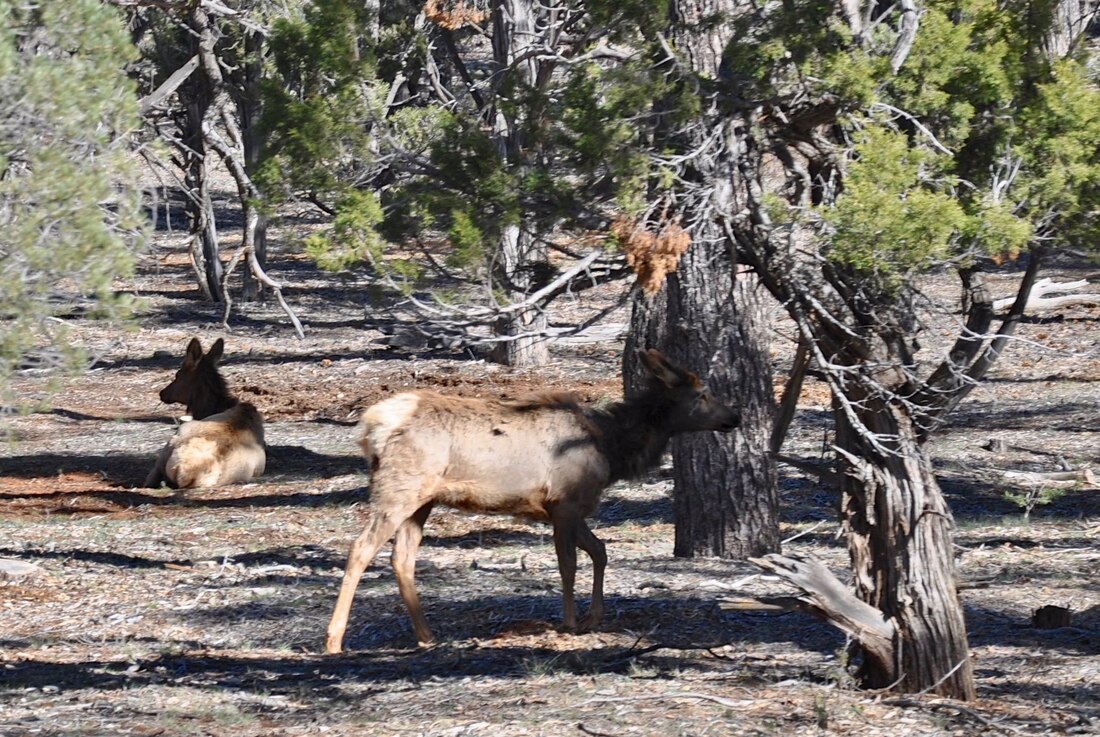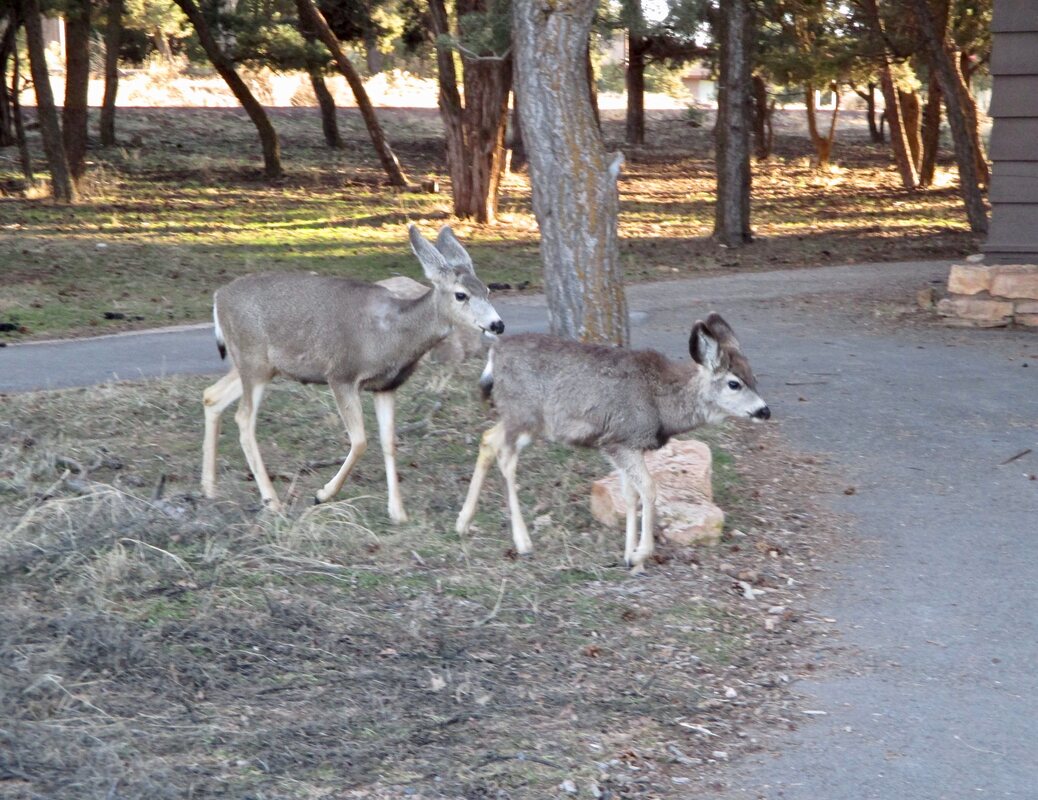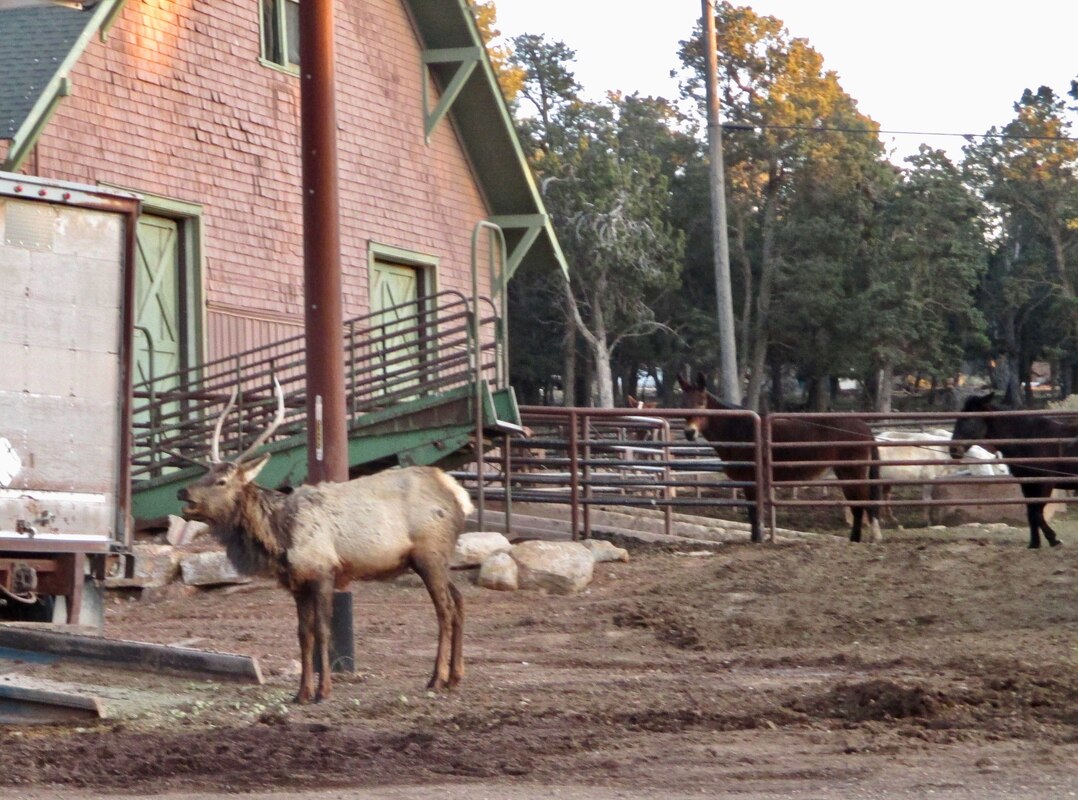|
Spotting wildlife on the South Rim is fairly easy to do in Grand Canyon Village during the spring and early summer seasons. The reason why is because the local Mule Deer and Elk with foals feel safe near human presence. Out in the Grand Canyon wilderness they are under a constant threat from hungry predators, like mountain lions and coyotes, so the herd animals seeking safety do tend to tolerate the humans in Grand Canyon Village. Caution always must be exercised when watching wildlife, because it is all too easy to forget that the animals are truly wild. Wild animals may look docile, but as soon as they feel threatened their demeanor quickly changes to a defensive stance. The best defense for a wild animal is to charge at threats that are too close or simply run away. Even mild mannered herd animals like Mule Deer can become a formidable threat when they feel cornered. Young elk can become especially dangerous when approached, because these animals know that they are larger than humans. Gambling on whether a wild animal will flee, charge or remain docile simply is not worth the risk and people that push their own luck by getting too close often end up with serious injuries. The National Park Rangers advise that it is best to keep 200 yards away from dangerous wild animals, like bears and mountain lions. Keeping a 100 yard distance from less threatening animals like bison allows plenty of space. The minimum safe distance for non-predator viewing is 50 yards, but in Grand Canyon Village this rule may be difficult to abide by, because there is so much wildlife present in the human traffic areas. In Grand Canyon Village, the rule of thumb is just to remain peaceful and give the wild animals some space, even when in close quarters. Standing still or slowly backing away is the best way to ensure that something like a bull elk will remain peaceful, even if it is only a few yards away when encountered. A golden rule that pertains Grand Canyon Village is to always use a flashlight when walking at night. The light will scare most animals away, but the main reason has to do with sleeping elk. Elk sometimes sleep on the ground in populated areas and tripping over a bull elk may result in being gored by the long sharp antlers. I lived and worked in Grand Canyon Village for two spring and summer seasons, so I had plenty of time to observe the wildlife behavior in this busy little city. During the daytime, many doe with foals feed on grass along the pathways in Grand Canyon Village. The young deer are used to being around humans and they were quite docile when walking by. Stopping to observe for too much time will sometimes spook the young animals and they will scurry away to a safer distance. Even so, the little Mule Deer foals are so cute that one simply has to stop to admire them! One thing that I noticed was that when the young deer in a grassy area pick up their heads to listen alertly all at one time, it pays too look around for trouble that is on the way. While chatting with a fellow employee next to a group of young deer that just went into the heads-up alert mode, the employee and I looked at each other and said, “I wonder what is spooking the deer?” … All of a sudden a huge young elk rounded the corner of the building in full gallop running scared and it nearly mowed both of us down while darting off into the distance. We just looked at each other and said at the same time, “Wow! … That sure was a close one!” This may seem strange, but the most dangerous animal at the Grand Canyon National Park does not have antlers or fangs. The gray squirrels may seem docile, but these little creatures carry a variety of nasty diseases, like rabies and the bubonic plague. On the average, one person is bitten by a squirrel at the Grand Canyon each day. Most visitors are bitten by squirrels while trying to feed them, even though the posted signs state that it is against the law to feed wild animals. The squirrels may seem playful and cute, but these little critters actually are the deadliest animals in the park, so it pays to keep some distance! As can be imagined, safety cannot be stressed enough, even when in a docile wildlife viewing area like the Grand Canyon Village. If the local wildlife is treated with respect, plenty of great opportunities will arise to view and photograph the wildlife up close when visiting during the spring and summer seasons!
0 Comments
Your comment will be posted after it is approved.
Leave a Reply. |
Leave no trace!
New!
Destination West YouTube channel! https://www.youtube.com/@DestinationWestOrg *The Destination West website upgrading project is well underway. Unique YouTube slideshows are replacing the outdated Flickr photo galleries. The new videos feature modern graphics and alternative music instrumentals that enhance the viewing experience. Some articles are being condensed, while others are getting much needed edits. As everybody knows, the bulk of the original articles and photos were published on the fly during the Covid camping venture and there were limitations. Upgrading is the way to go and more articles will receive a makeover each week until this project is completed. After that, I will be able to gather new material. There is light at the end of the tunnel!
JD Lane Archives
July 2024
Donations help the Destinaton West project continue into the future!
Go Fund Me! This website uses marketing and tracking technologies. Opting out of this will opt you out of all cookies, except for those needed to run the website. Note that some products may not work as well without tracking cookies. Opt Out of Cookies |


















